|
FAQs on Sponge Identification
15
Related Articles: Sponges in Marine
Aquariums
Related FAQs: Sponge ID
1, Sponge ID 2, Sponge ID 3, Sponge ID 4, Sponge
ID 5, Sponge ID 6, Sponge ID 7, Sponge ID
8, Sponge ID 9, Sponge ID 10, Sponge ID 10, Sponge ID 11, Sponge ID 12, Sponge ID 13, Sponge ID 14, Sponge ID 16, Sponge ID 17, Sponge ID 18,
Sponge ID 19, Sponge
ID 20, Sponge ID 21, & Sponges 1, Sponges
2, Sponges 3, Sponge Selection, Sponge Compatibility, Sponge Systems, Sponge Feeding, Sponge Disease, Sponge Reproduction,
|
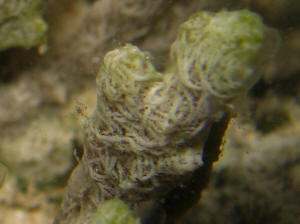
|
|
Id please! 11/7/10
I have many of those little animals in my aquarium and have not
yet find out what they are. They can change colour from white to
dark brown, they have some kind of limbs on their round bodies,
sometimes they can just be round as well. No visual mouth or eyes
and can move as 5 cm in 24 hours. Biggest of them is around 0,7
-0,8 mm
<Are you joking Jane?>
Then I found also those snails on my Zoanthus colony which where
nowhere else to be found. Zoanthus have been only half open these
days. Thanks.
<What? BobF>
Id please!
http://cid-3abc70133b7ce128.skydrive.live.com/redir.aspx?page=browse&resid=3
ABC70133B7CE128!225&type=5&Bpub=SDX.Photos&Bsrc=Photomail&authkey=FTQ93*17DY
8%24
<Won't open for me>
Re: Id please! 11/09/2010
Hi, again! What you mean by joking? These where my observations
about them.
<I could not, cannot follow what you had written; nor download
your image>
I have had them around two month and they game with the live rock
and have been growing bigger. Do you have any idea what they
could be. I am not shore you get the pictures so I send some new
ones as a link as well. http://forumbilder.se/show.aspx?iid=977201070609P54c1
-sorry about the dirty glass, here is one on the glass http://forumbilder.se/show.aspx?iid=df7201072011Pfb11
- here is one sitting on the rock and the other one behind him on
the red algae http://forumbilder.se/show.aspx?iid=667201072254P9062
- this picture is showing them on the bottom of the tank with the
different colours http://forumbilder.se/show.aspx?iid=0f7201072630Peb8a
- my best shot from the biggest one, now he is down in the bottom
as well and was not staying well on the picture, he is double in
size from the most others, he has been up on the glass as well,
but I missed the shot.
<Nor do these... Please, "practice" sending your
email/s to yourself... BobF>
<<Ahh, I see these linked images now, but can't exactly
make out what you're referring to. Could you make the
intended organisms larger, better resolved? B>>
Re: Id please! Motile sponge! 11/12/10
<<Ahh, I see these linked images now, but can't exactly
make out what you're referring to. Could you make the
intended organisms larger, better resolved? B>>
Hi again. Now I got the opportunity to make better pictures about
them. The biggest one climbed on the glass again
<Neat!>
so I tried to zoom in as much as possible. I tried even to fix my
description about them, so it would be better understood.
Description:
Size - the biggest is around 0,7-0,8 cm in diameter colour-they
can change colour from white to dark-brown- they do it quite
often without any visible reason.
body- they are round, not flat. They have no visual mouth or
eyes. They can have several limbs "feet" on their body,
which they can pull back inside of their body so they can be
totally round, it also seems that their limbs can come out from
different places from their bodies. It also looks like they
don't use their limbs for moving, but roll themselves around
instead.
When they are smaller they can have 3-4 limbs out at the same
time, when they get bigger it can be more.
Feeding- I have no idea- it can not be light, because most of
them stay in the bottom of the tank where there is a little
light. They can not eat food given to fish, because they
don't have any mouths. Filtration- maybe...well they must eat
something, to be able to grow and live.
Behavior- As I mentioned before most of them stay in the bottom
of the tank, but not all. They can move up to 5 cm in 24 hours.
They can climb up on the glass and stones.
<Thank you for sending these along Jane. This is a
sponge/Poriferan of some sort... and mobile! Most are not. And
not harmful, indeed, many folks consider their presence to be
indicative of good captive conditions. Please see here for more:
http://wetwebmedia.com/SpongeIDF10.htm
and the linked files above. Cheers, BobF>
|
|
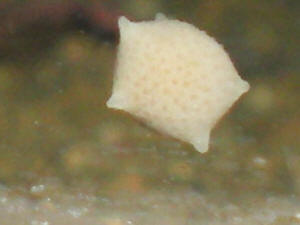 Yippee aye Yo, yippee aye yay Yippee aye Yo, yippee aye yay
|
|
White growth ID 8/23/10
Hey WWM,
<Mike>
I was hoping that someone would be able to provide a positive ID
on a growth that sprouted up about a week or 2 ago on my Zoa
frag.
<Mmm, yes. This is almost assuredly a sponge. See WWM re; many
examples of this sort of morphological et al. type>
It appears to be some kind of a hydroid, but I'm not sure
since it is not like any I have seen.
Would it be best for my Zoas if I removed it?
<Would likely, yes>
If I do need to remove it, would it be safe to inject it with
boiling water given how close it is?
<No need... just cut away (outside the system, underwater...
throw the water away after, rinse the Zoanthid colony...) and
toss. DO take care when handling Zoanthids... quite toxic
chemically. Please read here re:
http://wetwebmedia.com/zoanthidcompfaqs.htm
Thank you,
Mike
<Welcome, Bob Fenner>
|
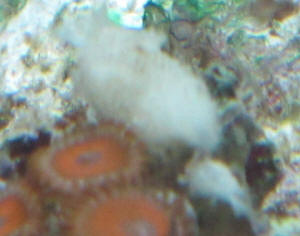 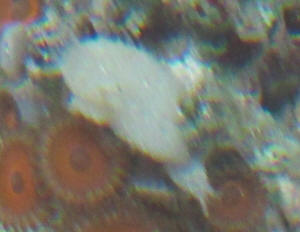 |
|
Invertebrate ID Help? Syconoid Sponges --
716/10
WetWeb-ers, Hello again,
<Hello, Drew, Lynn here this evening.>
I have another mystery critter for you to cut your teeth on
today.
<Go for it.>
A Cnidarian of some type seems likely, but I haven't found a
photo similar to my little beasties.
<Ah, you were looking in the wrong place!>
Attached are some photos of small (roughly 1/4") critters
that have recently been found infesting my rockwork and sump.
They are sessile and have a slender tubular body about the size
of a chubby grain of rice which projects perpendicular to their
chosen surface. At the free end is a structure (mouth/feeding
apparatus?) with a circular array of very short tentacles, less
than 1/3 the length of the body itself. They are the color of
oatmeal, or thereabouts.
<No worries, these are harmless/beneficial, filter-feeding
Syconoid sponges. There's an excellent close-up of one at the
FAQ titled 'Sponge Identification: Syconoid Sponges.
6/3/2009' at this link: http://www.wetwebmedia.com/SpongeID12.htm
. You can find more related FAQ's by entering the term
Syconoid in our Google search engine: http://www.wetwebmedia.com/Googlesearch.htm
>
As you can see in the pictures, they have a great liking for my
sump and have colonized it extensively.
<That's typical for these sponges.>
They are present on the rockwork as well, however, though the
highest concentrations seem to be underneath overhangs. Still,
some are present on the top of the rocks in full light and flow.
I can't say with confidence which conditions they're
favoring.
<These usually come and go in boom and bust cycles, especially
in new systems. In more mature systems, high numbers can indicate
a problem with excess nutrients.>
(Given the difficulty I had photographing them, I'm inclined
to determine that they do not show up on film and therefore must
be vampires or some faction of The Undead...)
<Heheee! No need to get out the garlic and wooden stakes for
these guys!>
Any ideas?
<Yep, if this is a new (or semi-new) tank, don't worry
about it. The large numbers you're presently seeing will
reduce to a manageable number all on their own. You'll likely
end up with a few here and there in the display and a bunch in
the sump. If this is a mature system, you've likely got a
nutrient problem going on. For more information on nutrient
control, please see the following link: http://www.wetwebmedia.com/nutrientcontrol.htm
>
Drew
<Take care, Lynn Z>
|
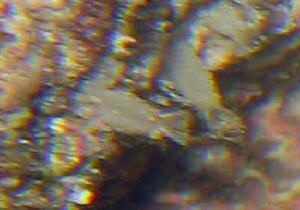
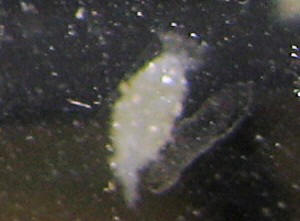 |
Re: Invertebrate ID Help? Syconoid
Sponges -- 7/17/10
<Hey Andrew!>
Lynn you're unflappable; first my double-pistoled shrimp and
now this...amazing!
<Heeee! This one was easy. The double-barreled pistol shrimp was
a new one for me as well. I'd read that Alpheids could
potentially have two snapping claws but had never come across one.
I'd say we both learned something with that query!>
I looked through the archives and find that these guys (or
their
near fellows) often appear as a fuzzy ball or Q-tip shaped object
as well:
<Yep, they're commonly called Q-tip or Pineapple
sponges.>
..turns out my girlfriend and I had noticed just such an organism a
week or two ago and when she suggested it may be related to the
present outbreak I told her she was silly and to leave this to the
experts...... obviously flowers are already en route, this will be
a long weekend.
<Hehehee! Sounds like you've got some 'splainin' to
do, and perhaps some wining and dining as well!>
FWIW, this tank has only been running since March,
<Yep, there you go. That's a fairly new tank.>
..albeit with rock and sand from an established tank. We're in
the midst of a hair algae outbreak as well, so I suppose your
nutrient problem hypothesis can't be ignored.
<Yep, something's feeding the hair algae and sponges. Be
sure to keep up with your water changes, and if you have a skimmer,
make sure it's in good working condition. Also, make sure
you're not over-stocked or over-feeding regarding livestock.
Finally, check your source water for nitrates and phosphates, and
if you don't have it already, get a light for your sump and set
up a section where you can add a macroalgae, like Chaetomorpha. The
macro will go a long way to controlling the hair algae and nutrient
issues. Do read through the related article mentioned in the last
email as I've only glanced over the topic here!>
Thanks for the help, as always.
<Always a pleasure, Andrew.>
Andrew
<Take care, Lynn Z> |
|
Is This A Polyp?/Coral ID 3/23/10
Hello WWM Crew,
<Hello Heather>
I just started my first salt water tank a few weeks ago and have
been reading the Internet for all my questions and have found
most of my answers on your page. Anyways I bought more live rock
to make a shelf in my tank and when at my local fish store I saw
this yellowish (not solid yellow) nickle sized thing I know many
things can hitchhike
<hitchhike>
on the live rock as I found I have a few mini brittle starfish
from a different live rock (sorry got off track) so I asked the
<person> working at the store what it was and he said it
was a polyp. I went home to research <research>
it to learn about it and can't find a polyp that looks like
the one in my tank and that's having me question it. I read
that polyp's are useual <usually> in groups and not
just one and cm.s in size and don't move.
This "polyp" that's in my tank is about a nickle
size round and a half in high <height> and moved from the
top of my shelf live rock to the under side of the live rock but
dose <does> show signs of being a polyp when the lights are
out it does release it tentecials <tentacles>. My question
is can you tell me if this sounds like a polyp and how I can go
about finding out what kind and if not what could it be?
<A well resolved photo is really needed to determine, although
not likely a polyp.>
Thank you very much
<You're welcome. James (Salty Dog)>
Heather
South Florida
Re Is This A Polyp?/Coral ID 3/23/10
Hello
<Hi Heather>
Lol... I'm so sorry about the spelling of the last email (and
this one maybe) as I was/am typing from small keys on my phone.
(not only but I'm not great at spelling...all I can do is
laugh at myself)
<No problem, and I likely would not go on the internet if I
had to do it by phone. Too small a screen/keys for me to be happy
with.>
My phone is my only way of getting online at this time and it
doesn't have a spellig/grammer <spelling/grammar> check
:(..... I'm very sorry. I can email a photo but being that my
phone is the only way to do so I am not sure what size the photo
will come to you as and don't know how to make it smaller if
needed. So I guess my next question is may I send the photo
anyways and see if it's ok?
<Sure, go ahead and send. Hopefully it will be clear enough to
hopefully ID.>
Very Sorry,
<No problem Heather. James (Salty Dog)>
Heather
|
|
Re Is This A Polyp?/Coral ID 3/23/10
James,
<Heather>
Here is this photo and I'm sorry but on my end it seems like
a big photo hopefully you can get it to finally help me....
<Photo is not clear/resolved enough for me to take a stab.
Perhaps Bob can make an educated ID of it. Do read the dailies
tomorrow for possible input on this ID.><<Just a guess
period, but considering where it's located, the shape,
colour... my bet is that this is a sponge. RMF>>
The "polyp" I am asking of is the yellowish thing
hanging from the rock in the middle of the photo and as I wrote
before it's a nickle in size round and about a half inch high
and it has moved again and it has squeezed itself between two
rocks and it almost looks like it's body is a jelly form.
Thank you for taking your time with me and understanding my
issue...;)
<No problem Heather, and tune in to the daily FAQ's
tomorrow. Go here and click on Today's FAQ's. Should be
posted around 2:00pm your time.
http://www.wetwebmedia.com/index.html
James (Salty Dog)>
Heather
|
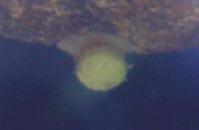 |
|
Re: More Re: is this a polyp?
3/25/10
<Bob's bet is that this is a sponge, so the tentacles
likely go along with the bet. Bob?><<Maybe summat living
inside the spaces in the sponge itself... Ophiuroids perhaps...
If it were mine, I'd reach in and give this ball a gentle
squeeze... I suspect a good deal of this mystery would be solved
thus. RMF>>
Thank you once again for your input.
James
<And you my friend. BobF>
Re Is This A Polyp?/Coral ID 3/23/10 - 3/24/10 -
3/25/10
Thank you once again for your input James. And Bob.
<You're welcome. James (Salty Dog)>
Re Is This A Polyp?/Coral ID 3/23/10 - 3/24/10 -
3/25/10
Wow really that sounds fun in a werid <weird>
way...lol...
<Mmm, now you got me thinking about Bob. Kind of akin to
squeezing black heads off someone's face:) But then again, I
have yet to meet a beer drinker who was weird.>
It has moved itself into a area of the tank where I can't
reach it. As soon as I can reach it with out moving my live rock
I will try that and let you know. Is it safe to touch with my
bare hands?
<Reportedly, there are some species of sponge that contain
neurotoxins, so to be safe, you may want to wear a pair of those
throw away surgical gloves.>
Once and again thank you very much
<You're welcome, Heather. James (Salty Dog)>
Re Is This A Polyp?/Coral ID 3/23/10 - 3/24/10 - 3/25/10
- 3/26/10
One more question by squeezing it will it release anything and
harm my fish that are in my tank?
<Bob mentioned "a gentle squeeze", and I'm sure
he would not suggest this if there was a downside. I'd leave
be and enjoy. James (Salty Dog)><<Correct.
RMF>>
|
|
Sponge? (Mmm, Rhodophyta maybe) --
03/01/10
Crew-
<<Howdy Dan>>
Can't find a picture like this on your site so far, so I
attached a photo from my tank.
<<I see this>>
I have 10-12 of these little red dudes attached to live rock, all
within 3-4" of the substrate, and none bigger than
¼" in diameter. They look like a semicircular
portion of a red mushroom and only started showing up about two
months ago. My tank is about 13 months old, and has numerous
corals and other inverts. Could they be some sort of sponge?
<<A possibility, or maybe even a tunicate 'but
studying the photo, I'm inclined to think this is a
Rhodophyta (red algae)'¦with some 6,000 or more
species to choose from>>
Thanks,
Dan
<<Happy to share'¦ EricR>>
|
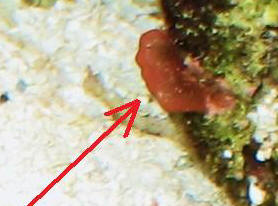 |
|
Re: name of algae, new... -- 02/08/10
Thank you for your quick answer. Can you help me again with this
one? It was taken Again in N-Sulawesi on a house rif in Lembeh
street.
<Ahh! Have spent quite a few vacations at KBR and Lembeh
Resort... there are now some 11 resorts being built and up there,
as well as some boats that come over from the Bunaken/Manado
side>
That same stuff I also found in the Philippines, a year ago, but
could not found out what is was.
Thanks again Bob.
Greetz Tineke
<I don't know what this is... looks like some sort of
Chlorophyte that is overgrowing a stony coral skeleton to me. Did
you happen to touch, move it with your hand that you recall?
BobF>
|
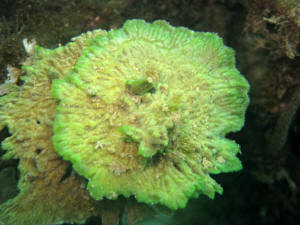 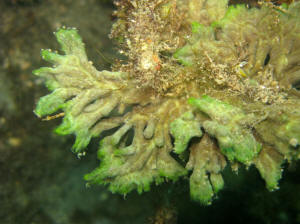 |
Re: name of algae --
02/08/10
Hay Bob....indeed it looks like overgrow of coral. I did found also
the one from the Philippines which I send you now. There is a very
close-up so maybe you can see what it is. But than the first
pictures I send you, there was one who looks like a flower
(886T-5221)...maybe this algae used base as a kind of stabilization
and grow bigger later. I didn't touched it but as I remember it
was on the edges not very *stony*
Greetz Tineke
<I'll be... you know, this close up reminds me of... some
sort of Ascidian colony; with some filamentous Green algae growing
at the apices of the branching. I do wish we had some on hand to
section and look at under a 'scope. Am going to ask LynnZ to
take a look here as well. BobF> |
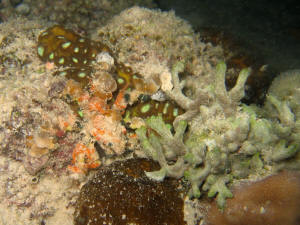  |
Re: name of algae -- 02/09/10
Thank you Bob, I wait till you get an answer. When ever I found
that again I will take a little piece with me...although it is
forbidden (just for sciences :)) unless LynnZ comes with the
name.
I look forwards to the answer!
<Me too Tineke>
Greetz from Holland
Tineke
<And back at you as they say, from S. California. BobF>
Re: Re: name of algae, perhaps a Poriferan --
2/10/10
Thank you Bob, I wait till you get an answer.
<<Hello Tineke and Bob, Lynn here today.>>
When ever I found that again I will take a little piece with
me...although it is forbidden (just for sciences :)) unless LynnZ
comes with the name.
<<Hmmm, I wish I could say that I have, but all I can offer
are more possibilities. One that comes to mind is that what
we're seeing isn't something actually overgrowing a coral
skeleton, but instead perhaps a branching Demosponge, order
Haplosclerida, all by itself. Perhaps the sponge is dead and has
a growth of some sort of filamentous algae covering the
openings/osculae at the tips? Apparently, these sponges are found
around the Philippines. I'd feel a whole lot more confident
though, if I could find and see a close-up of one, but I
haven't been successful. I know that these sponges are very
fibrous but I'm not sure if they're as ropy-looking as
what I see in your close-up photo.
If it's not a branching sponge, then I'm guessing
it's some sort of Chlorophyte or Phaeophyte overgrowing a
coral skeleton. What bothers me about this theory is that the
entire winding mass appears almost too smooth and web-like in its
covering of the skeleton. If this were an algae, it seems like
there would be stem ends extending here and there from the mass,
especially considering the fact that it winds around some fairly
narrow branches. I don't see any. Everything just seems a
little too close and compact.
One last possibility I looked into was an Ascidian/tunicate
overgrowing a coral skeleton. Unfortunately, I didn't have
much luck finding any suitable candidates. Of the three I
mentioned, I'm leaning towards the sponge, especially after
having seen the first link below (note the small osculae).
Sponge, order Haplosclerida. See photo under 'Sponge pictures
of week 3':
http://www.naturalsciences.be/active/expeditions/archive2005/patagonia2/page5
Another sponge in this order, found in Hawaii and the Philippines
(note branching variety):
http://www2.bishopmuseum.org/HBS/invertguide/species/gelliodes_fibrosa.htm
Ascidian overgrowing coral:
http://life.bio.sunysb.edu/marinebio/cr_36.jpg >
I look forwards to the answer!
<Me too Tineke>
<<Same here, Tineke>>
Greetz from Holland
Tineke
<And back at you as they say, from S. California. BobF>
<<And the same from Washington state as well. Take care,
LynnZ>>
>Well done, as usual, Lynn. BobF<
|
|
|

